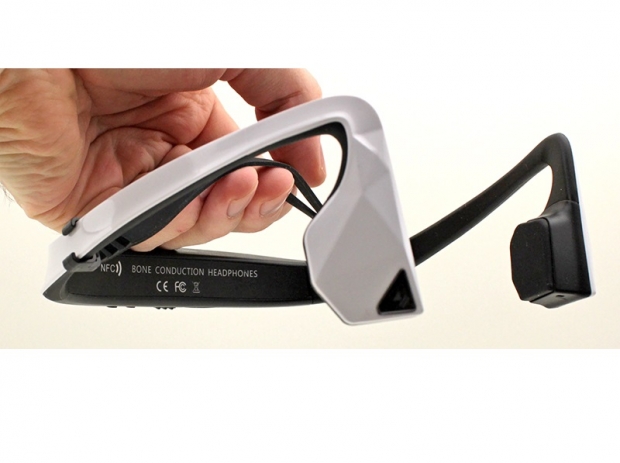DIGICare’s bone conduction headphones, named simply DO, are lightweight and they are designed for an active lifestyle. The main advantage over classic headphones is that your ears are not covered and you will be able to hear ambient noise all the time. For example when you are running, hiking or driving a bike while listening music it is of main importance to hear approaching cars, or bears. In this review we want to share our findings after playing around with DIGICare DO headphones for several weeks.
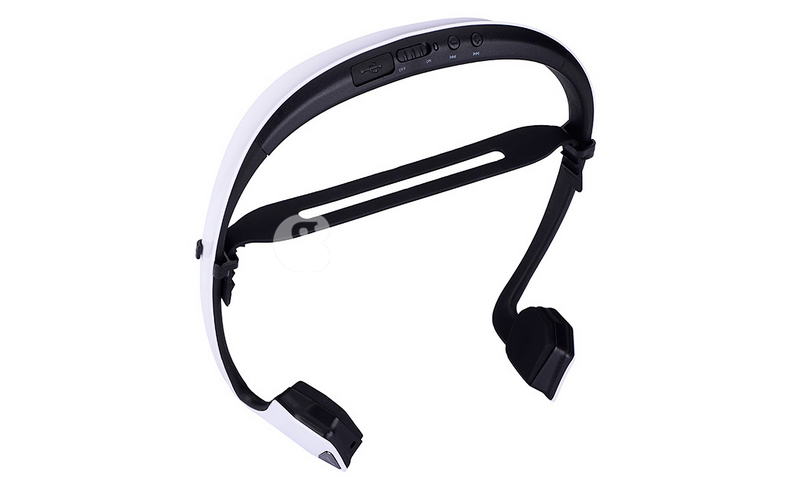
How it works?
In order to hear sound, the sound needs to reach the cochlea, which happens in both cases (standard headphones and bone conducting headphones) through the vibration of small bones found behind the eardrum. This means that there is really no need for the sound to pass through the middle ear and eardrum like with the standard headphones. This is the second advantage of this technology, as ears will not get damaged from very loud output as is the case when the headphones are placed into or over the ear (here is the link if you want read more about the effects of exposure to loud noise).
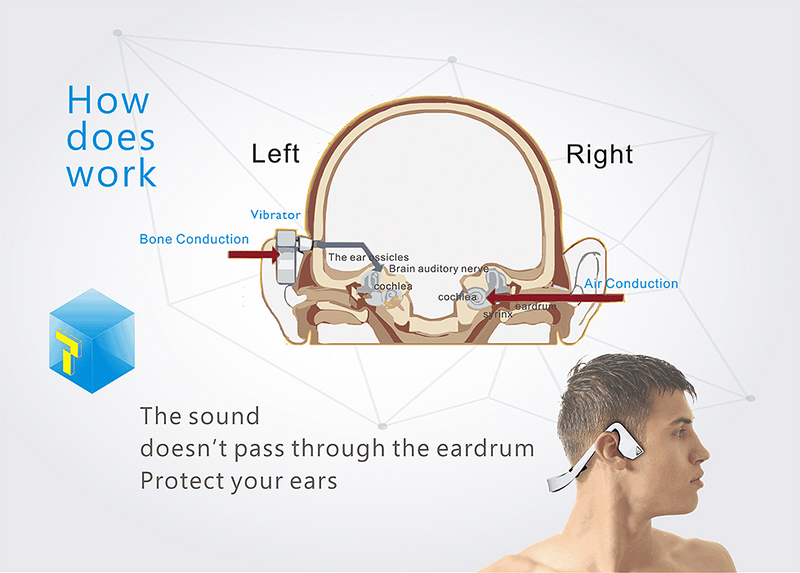
Specifications and Packaging
| General | |
| Brand | Digicare |
| Color | White |
| Material | Plastic |
| Specification | |
| Sound Type | Stereo |
| Bluetooth Version | V3.0 + EDR |
| Transmission Range | 10m |
| Frequency Range | 20-20KHz |
| Mono/Stereo | Stereo |
| Impedance | 32? |
| Receiving Sensitivity | 88dBm |
| Bluetooth Pofile | HFP, HSP, AVRCP, A2DP |
| FM | NO |
| TF Card | NO |
| Mic | Anti-interference microphones, -50DB |
| Speaker | Bone conduction technology speaker, 1w dual speaker |
| System Language | English-Prompt tone is English |
| Battery | 260mAh Polymer battery |
| Charging | Micro USB port |
| Charge Time | <3 Hours |
| Talk Time | Approx. 6 Hours |
| Standby Time | Approx. 240 Hours |
| Dimensions & Weight (Main Product) | |
| Dimension | 145 x 135 x 13mm |
| Weight | 55g |
| Package Contents | |
| 1 x Headphone | |
| 1 x PBT bandage | |
| 1 x Bag | |
| 1 x Box | |
| 1 x Charging cable | |
| 2 x Earplug | |
| 1 x User Manual | |
The headphones are shipped in a simple cardboard package. The black package looks interesting and is compact at 17.5 x 13.5 x 6 cm.
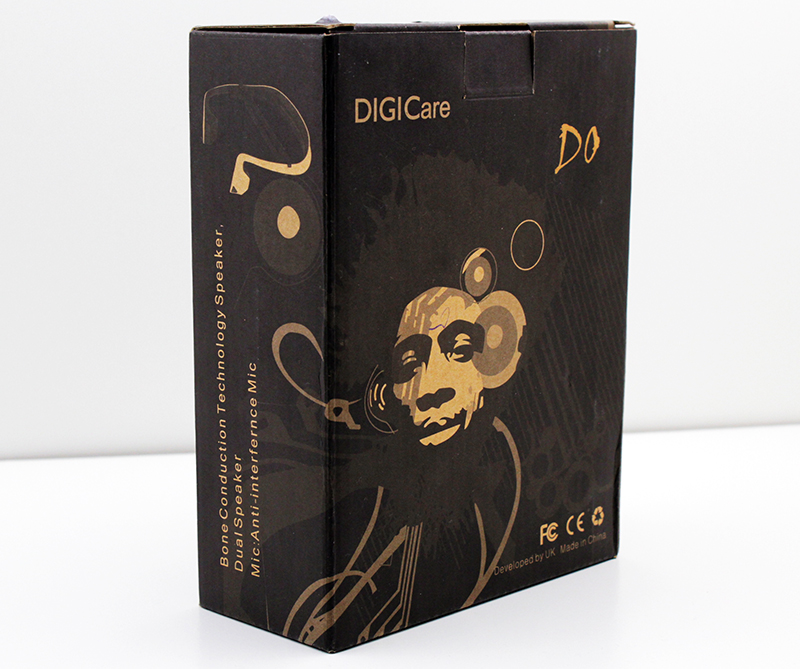
Some specifications, like the playback time and weight are written on the side.
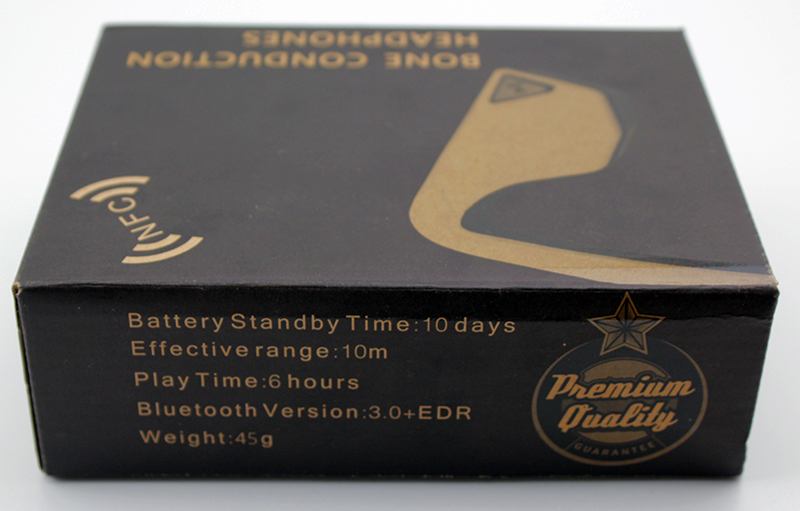
Inside you will find a small trunk which holds the headphones and accessories.
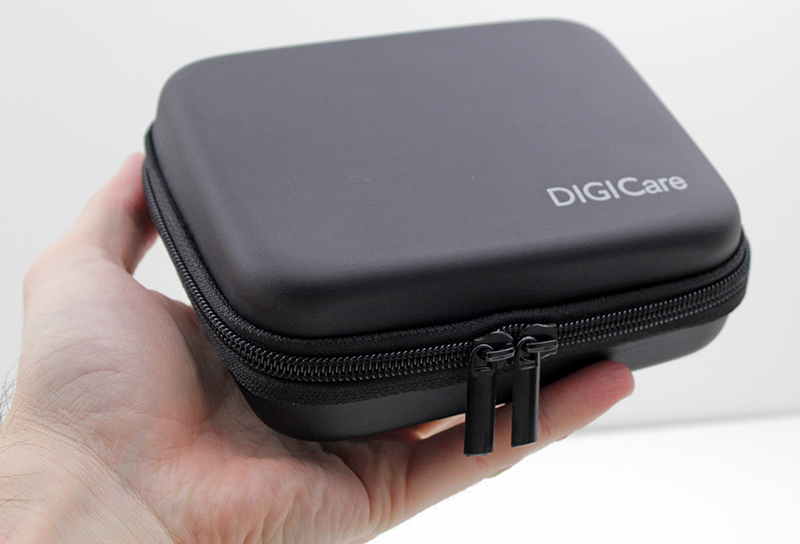
The earplugs are something we did not expect to see. Since bone conduction headphones do not cover your ears, the earplugs could be useful in some scenarios.
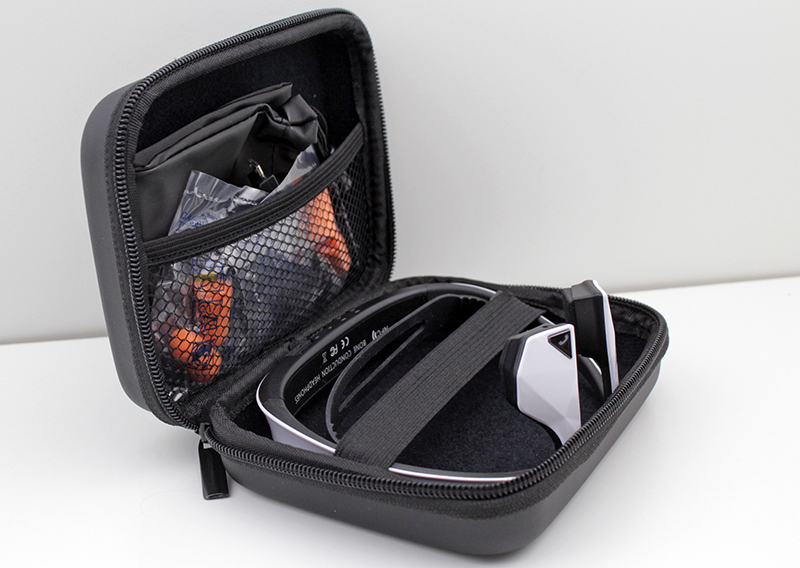
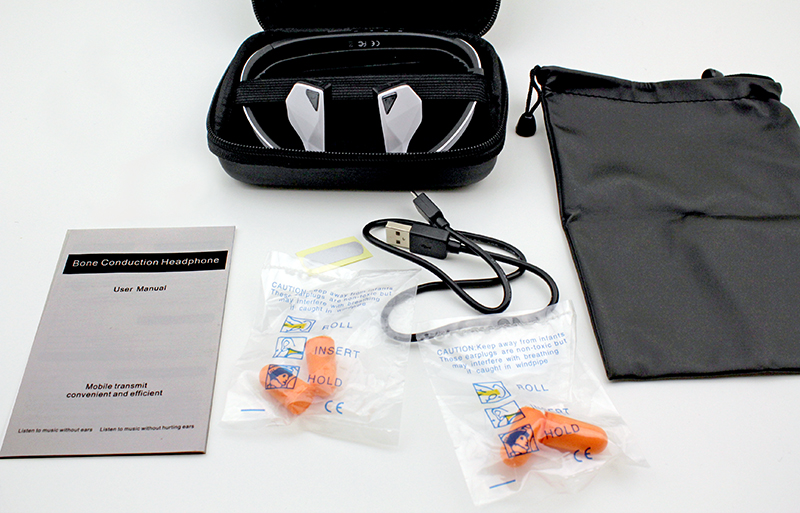
A closer look and experiences
The headphones are plastic and weight only 45g. A combination of glossy white and matte black plastic usually works well, and in this case it gives the headphones a sleek look.
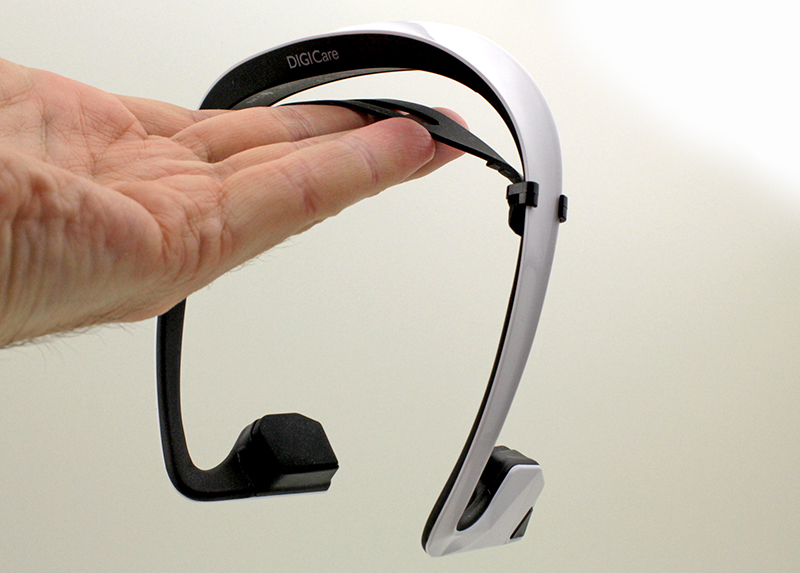
The plastic is robust yet flexible, so even after a few weeks of regular use we had no issues and we cannot complain about the build quality. Ergonomics are a different story, but from what we saw, we wouldn’t recommend them in case you happen to have a small head. This is obviously bad news for a lot of teens and women.
As you can see, the bone conductivity headphones are used a bit differently than your run of the mill headphones.
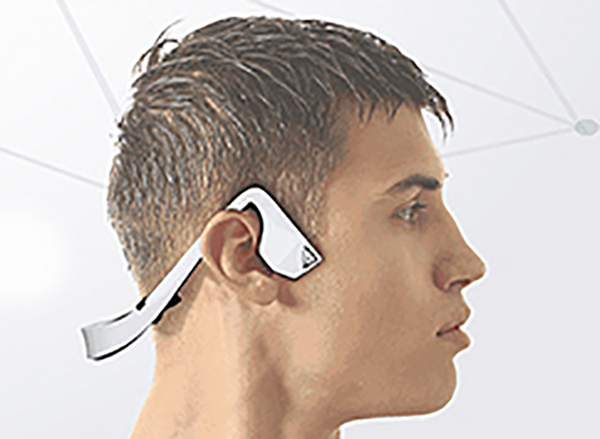
An adjustable strap is available to help out users with a smaller cranium, but in our experience it didn’t help in all situations, so one unwitting test subject had the headphones slide down despite tightening the strap as much as possible.
If you have an average sized head, this won’t be a problem and you will able to adjust the headphones properly, so the device will stay in place while jogging. However, the design simply won’t work with kids. This is a pity since teens tend to pump up the volume on their mobile devices, risking hearing damage. A lot of them also use headphones while engaging in sports, so being able to hear oncoming traffic is a good idea.
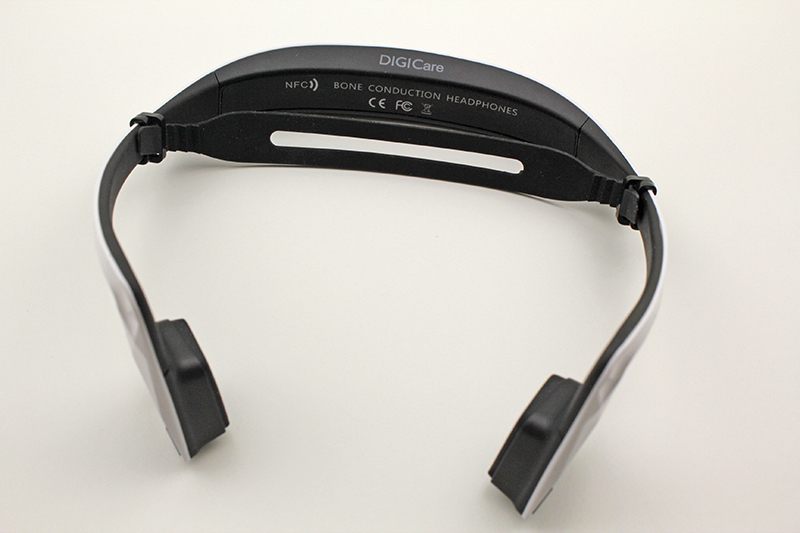
The part of the headphones with the vibrators is pressed against bones in front of the ears. To ensure good conductivity you may tighten the strap to ensure that there is enough pressure on the bones.
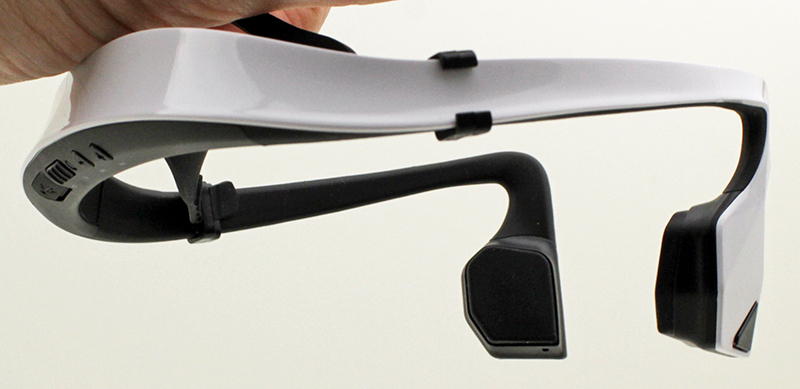
The volume up and volume down buttons are placed at the back, so they’re behind your head all the time. It might not sound very practical, but you get used to it – it’s just the price you have to pay for such a design. The mini USB charging connector, On/Off switch and LED lights are placed next to the volume buttons.
It took me a while to get used to the layout, but with bone conductivity headphones designers really don’t have a lot of options. Users with long hair might have a hard time reaching the buttons, depending on how they choose to wear their headphones.
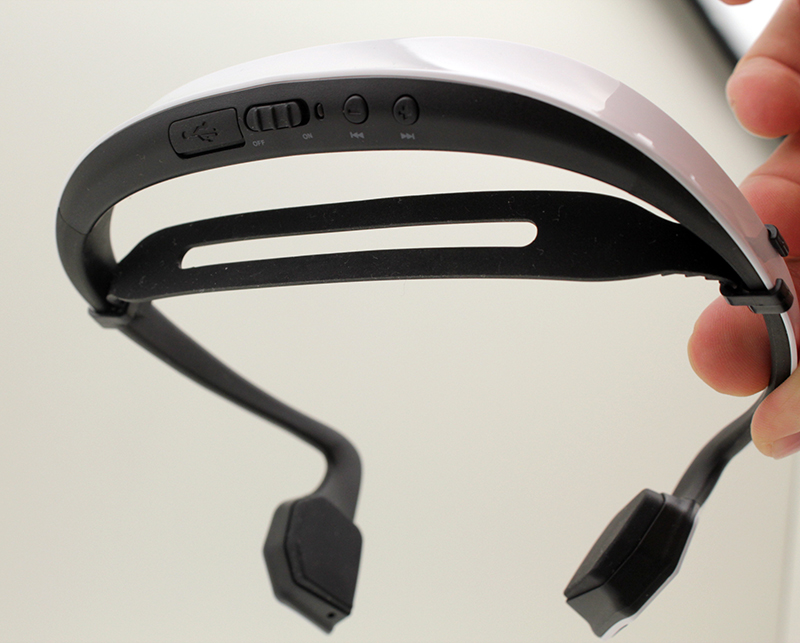
On the left side you will find a call answer/drop call button and a built-in microphone.
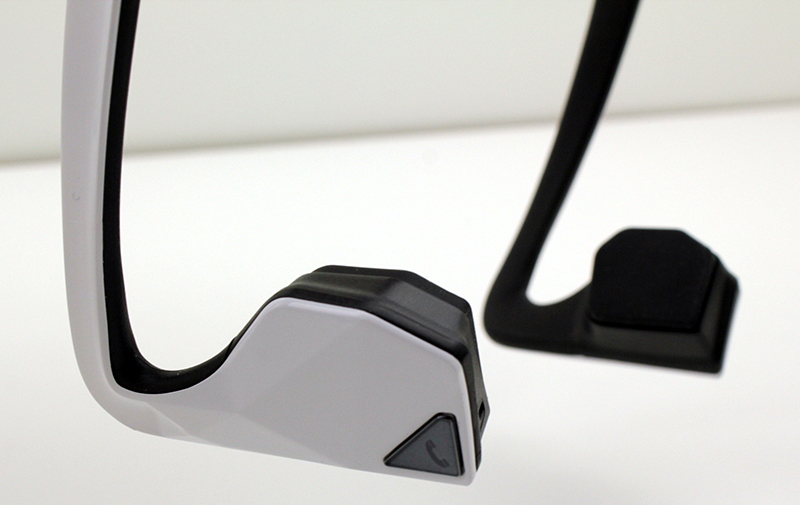
The right side features the play and pause button. In other words, two of the most commonly used buttons are easily accessible, which is good news. As for the volume, well, you can always control the volume on the playback device.
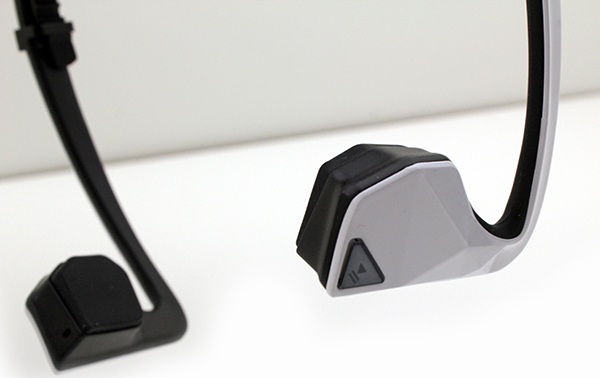
Unlike traditional headphones, there are no drivers, just mechanical assemblies that turn audio into vibration, which is then transmitted via rubber inlays onto your bones and to the cohlea.
When you max out the volume, you could feel slight vibrations, but we only experienced this feeling on a few occasions.
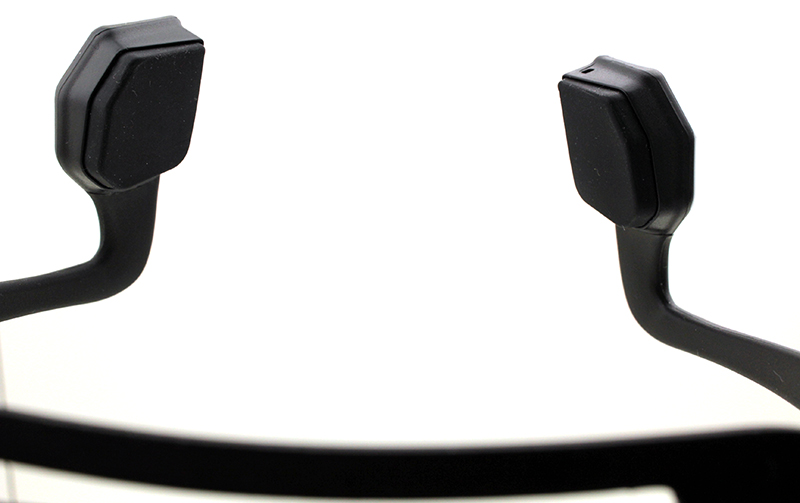
More about our experience
Personally, I found the design excellent for outdoor activities, but there are some limitations. For example, if you’re planning to go skiing, you may have trouble putting on a hood or ski mask. Luckily, summer is coming and you won't need a hoodie, but you may need a pair of sunglasses.
As far as phone functionality goes, I was able to hear incoming calls quite well, but I sometimes heard complaints from the other side of the line, as the microphone wasn’t very sensitive. This is not a huge issue, since this sort of product won’t be used to make many phone calls.
The good news is that bone conductivity headphones allow you to enjoy musing while staying alert, so they are ideally suited for all sports that could put you in harm’s way if you don’t hear oncoming traffic or other ambient sounds.
Oddly enough, while the headphones rely on bone conductivity and don’t have drivers in the traditional sense, you can still hear the music once you take them off. The headphones don’t isolate all the sound, so people around you could also hear what you’re listening to.
In terms of audio quality, bone conductivity is a mixed bag. It’s good for some genres, but not as good for others. For example, if you’re listening to a rock tune, you’ll hear excellent guitar solos, but vocals may not be as rich. In case you’re into bass-laden music, don’t expect miracles, either. However, if you’re more of a Vivaldi guy, you can expect a very nice experience with Four Seasons.
Conclusion
DGICare DO bone conduction headphones are designed for an active lifestyle, for sports activities that are made safe or more enjoyable by being able to hear ambient noise. Basically they are good for safety, and you should not be at risk of hearing damage, either.
Also, in case you already have damaged hearing, for example a bad middle ear or eardrum, bone conductivity should help you out.
Of course, there’s another group of users who might like such solutions – people who just don’t like to cover their ears or place anything in them.
The headphones use Bluetooth and NFC for pairing, which works quite well. They can be fully charged in about two hours, which is enough for six hours of playback. In some situations, they can come in handy as a traditional headset, for example if you want to take a call while cycling.
We received the sample via Geekbuying, which sells the Digicare bone conduction headphones for $69.

